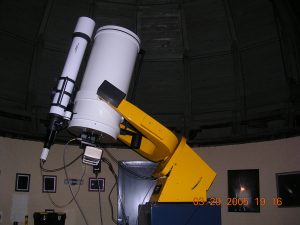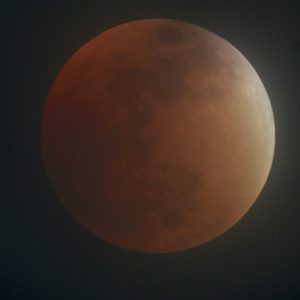
TUSCALOOSA, Ala. — The University of Alabama department of physics and astronomy will host a free public viewing session for the super wolf blood moon total lunar eclipse on the evening of Sunday, Jan. 20, at the observatory atop Gallalee Hall.
Weather permitting, doors will be open from 8:30 p.m. to midnight. The umbral phases of this eclipse last from 9:33 p.m.-12:50 a.m., and the total phase from 10:41-11:43 p.m.
This is the first lunar eclipse of its kind visible from Tuscaloosa since Sept. 27, 2015.
“We’re well placed to see the whole thing if the weather holds,” said Dr. William Keel, professor of physics and astronomy.
“We’re having it on Jan. 20 instead of Jan. 21 because the eclipse is taking place on the 21st on universal time,” he said. “Knock six hours off of that time for our time, and it takes place on the evening of Jan. 20 here, Sunday.”
Those in attendance will be able to view the eclipse through the observatory’s main 16-inch telescope or through several 5-inch telescopes with wide lenses. The smaller telescopes are perfect for placing cell phone cameras in the eyepiece to take photos of the eclipse, Keel said.
Unlike a solar eclipse, a total lunar eclipse can be viewed with the naked eye and has several phases that take hours to progress through.
The first is a penumbral phase where the earth covers up part of the sun as the moon keeps moving. He said that phase will already be in progress when the observatory opens at 8:30 p.m.

The next phase will be the partial phase, which begins at 9:33 p.m. Following that is the totality phase when the moon is completely in the umbra and, if clouds and volcanic eruptions haven’t decreased visibility, the moon should be completely eclipsed, fully visible and either orange or red in color from between 10:41-11:43 p.m. in Tuscaloosa.
“With total lunar eclipses, they’re leisurely,” he said. “The total phase lasts about an hour. With a solar eclipse, the total phase lasts about 2 minutes. So, you can take your time and enjoy it.
“It’s just a nice treat for the eyes to see something happening in the sky that we don’t see every night.”
As far as the long name of this specific type of total lunar eclipse, Keel said it’s for several reasons, none of which is he personally fond.
“It is a thing designed to make astronomers’ eyes roll,” he said, while laughing. “Rattling around in the new media age, every lunar eclipse gets labeled as a blood moon now because of the color.
“I’m not sure why it’s called a wolf moon. It’s a tribal thing possibly. But the super title is because it’s a full moon happening at a time when it’s closer to the earth than usual, so it looks that much bigger and brighter.”
Contact
Jamon Smith, UA communications, jamon.smith@ua.edu, 205-348-4956
